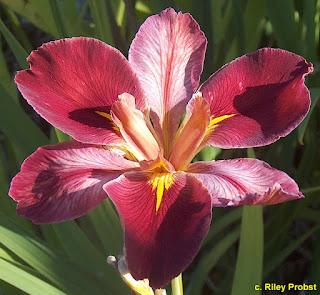By Gary Salathe
The Louisiana Iris Conservation Initiative (LICI),
of which I am part of, recently began our first iris plantings out in the
swamps and marshes of Southeast Louisiana for the 2020 fall and winter planting
season.
In a previous World of Irises posting I explained how
our group locates native Louisiana irises that are threaten with destruction and,
after getting the landowner’s permission, relocates the irises into public
refuges and nature preserves. The idea
being that it is hard to get the public on board with helping to preserve and
protect native Louisiana irises if they can’t experience them blooming because
they can only be found in the deepest corners of the swamps and marshes hidden
from view. If we can’t bring the public to the irises
then we will bring the irises to the public, is the idea.
Photo: Volunteers
on a Louisiana Iris Conservation Initiative project working in July digging irises from a site west of New Orleans on property that
is slated for development.Starting in late May of this year, and especially in June
and July, volunteers on multiple events organized by the LICI dug up around 6,000 I. giganticaerulea
Louisiana species irises from properties that have plans for development,
as donations from homeowners that removed irises from swamps and planted them on
their property or from sites where irises from past rescued events were planted
over the last two years.
Photo: Masks and social distancing was the order of
the day in the summer LICI rescue events. The irises were planted into containers at an iris holding
area we set up in New Orleans since they were dug up as the iris dormant
season was about to begin. The plan
was for the irises to strengthen for a few months so that we could plant them in the swamps after they began their fall growth period.
Photo:
Rescued irises being planted into containers in July at the LICI iris holding
area in the Lower Ninth Ward neighborhood of New Orleans. We were finally ready to start planting irises in late
October after a few close calls by hurricanes delayed us. The first project on October 21st.,
which was held at the Bayou Sauvage National Wildlife Refuge in New Orleans East, had just a small
number of volunteers to show how these events would work for the refuge
staff’s approval in the COVID 19 era.
Everything went well and I. giganticaerulea Louisiana species irises were planted. A decision was made that we would be OK to
expand the number of volunteers for future projects.
Photo: The first irises of the 2020 planting season
are dug up from our iris holding area on the morning of October 21st to be planted at the Bayou Sauvage National
Wildlife Refuge. The second volunteer event was also a small
one. It was held at St. Bernard
State Park, which is located southeast of New Orleans. In the first of what we hope will be many, I.
giganticaerulea Louisiana species irises were planted, some threatened irises
were dug up and an area of a pond bank was cleared of brush to help the public see the irises.
Photo: Irises being planted at St. Bernard State Park on October
28th, the day before Hurricane Zeta hit New Orleans. The next day our iris holding area was hit by
Hurricane Zeta on the evening of October 29th with the eye of the
hurricane passing directly overhead!
Photo: The iris holding area after branches and
other debris were picked up after the Hurricane Zeta. A power pole leaned over at the entrance, but
otherwise we escaped with no damage to the irises or the site. On November 4th we held our first
large-scale iris planting volunteer event at the Bayou Sauvage National
Wildlife Refuge. We went back to the
refuge because the water level was down since winter rains had not begun
yet. This allowed us to get into areas
that we have not been able to plant irises in over the last two years during
events held in late December or early January due to the water being high. During the event, which was organized by LICI,
seventeen volunteers from various non-profits, including LICI volunteers, planted I. giganticaerulea Louisiana species
irises. The other groups included; The Friends of the
Refuge, Limitless Vistas, Common Ground Relief and the Native Plant Initiative
of Greater New Orleans.
Photo: Volunteers from various community non-profits
involved in marsh restoration planting Louisiana irises on November 3rd
in the Bayou
Sauvage National Wildlife Refuge.We’re off to such a great start that we have a volunteer
event planned with an area Boy Scout troop for Saturday, November 14th
to go back to the site west of New Orleans and dig up more irises to replace
the ones we have taken out of our iris holding area! (The list of sites that have sent us a request to plant irises continues to grow.)
The Louisiana Iris Conservation
Initiative website can be found here: https://www.licisaveirises.com/
Our Facebook page can be found
here: https://www.facebook.com/Louisiana-Iris-Conservation-Initiative-104321594594214/?modal=admin_todo_tour



















